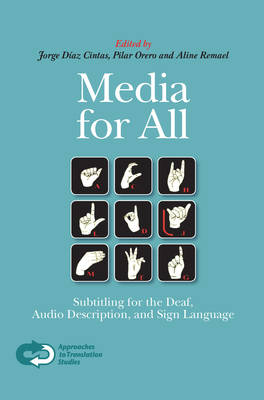
- Afhalen na 1 uur in een winkel met voorraad
- Gratis thuislevering in België vanaf € 30
- Ruim aanbod met 7 miljoen producten
- Afhalen na 1 uur in een winkel met voorraad
- Gratis thuislevering in België vanaf € 30
- Ruim aanbod met 7 miljoen producten
Zoeken
Omschrijving
This book, a first in its kind, offers a survey of the present state of affairs in media accessibility research and practice. It focuses on professional practices which are relative newcomers within the field of audiovisual translation and media studies, namely, audio description for the blind and visually impaired, sign language, and subtitling for the deaf and the hard-of-hearing for television, DVD, cinema, internet and live performances.
Thanks to the work of lobbying groups and the introduction of legislation in some countries, media accessibility is an area that has recently gained marked visibility in our society. It has begun to appear in university curricula across Europe, and is the topic of numerous specialised conferences.
The target readership of this book is first and foremost the growing number of academics involved in audiovisual translation at universities - researchers, teachers and students - but it is also of interest to the ever-expanding pool of practitioners and translators, who may wish to improve their crafts. The collection also addresses media scholars, members of deaf and blind associations, TV channels, and cinema or theatre managements who have embarked on the task of making their programmes and venues accessible to the visually and hearing impaired.
Thanks to the work of lobbying groups and the introduction of legislation in some countries, media accessibility is an area that has recently gained marked visibility in our society. It has begun to appear in university curricula across Europe, and is the topic of numerous specialised conferences.
The target readership of this book is first and foremost the growing number of academics involved in audiovisual translation at universities - researchers, teachers and students - but it is also of interest to the ever-expanding pool of practitioners and translators, who may wish to improve their crafts. The collection also addresses media scholars, members of deaf and blind associations, TV channels, and cinema or theatre managements who have embarked on the task of making their programmes and venues accessible to the visually and hearing impaired.
Specificaties
Betrokkenen
- Uitgeverij:
Inhoud
- Aantal bladzijden:
- 256
- Taal:
- Engels
- Reeks:
- Reeksnummer:
- nr. 30
Eigenschappen
- Productcode (EAN):
- 9789042023048
- Verschijningsdatum:
- 1/01/2007
- Uitvoering:
- Paperback
- Formaat:
- Trade paperback (VS)
- Afmetingen:
- 155 mm x 234 mm
- Gewicht:
- 358 g

Alleen bij Standaard Boekhandel
+ 256 punten op je klantenkaart van Standaard Boekhandel
Beoordelingen
We publiceren alleen reviews die voldoen aan de voorwaarden voor reviews. Bekijk onze voorwaarden voor reviews.







